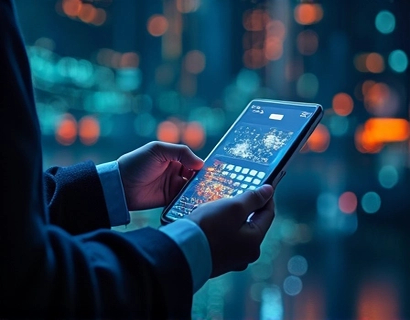Discovering the Ultimate Repository of Accessible Innovations: Top Universal Apps for Enhanced Productivity and Creativity
In an era where technology is rapidly advancing, the importance of accessibility cannot be overstated. A growing number of applications are merging cutting-edge technology with universal accessibility, creating tools that not only enhance productivity and creativity but also ensure that everyone, regardless of ability, can benefit from these advancements. This article delves into a curated collection of innovative apps that exemplify this fusion of technology and accessibility, designed to make advanced tools usable and beneficial for all users.
The concept of universal design in technology aims to create products and environments that are usable by all people, to the greatest extent possible, without the need for adaptation or specialized design. In the context of applications, this means developing software that is intuitive, flexible, and adaptable to various user needs. The following sections explore a selection of top universal apps that embody this philosophy, offering features that cater to diverse abilities and enhance the user experience.
Enhancing Productivity with Universal Apps
Productivity apps are essential tools for managing tasks, organizing information, and boosting efficiency. For users with disabilities, traditional productivity apps often present barriers. However, a new generation of apps is changing this landscape by incorporating universal design principles. These apps ensure that everyone can access and utilize their features effectively.
One standout app in this category is Notion. Notion is a versatile workspace that combines notes, tasks, databases, and wikis into one integrated platform. Its accessibility features include keyboard navigation, screen reader support, and customizable text sizes and colors. Users can create and manage their workflows seamlessly, regardless of their physical abilities. The app's flexibility allows for personalized workspaces, making it an excellent choice for individuals with different needs.
Another notable app is Todoist, a task management tool that helps users stay organized and on top of their to-do lists. Todoist offers a range of accessibility features, such as voice input, high-contrast mode, and screen reader compatibility. These features ensure that users with visual or motor impairments can easily create, prioritize, and track their tasks. The app's intuitive interface and robust feature set make it a powerful tool for enhancing productivity for all users.
Boosting Creativity with Accessible Tools
Creativity is a fundamental aspect of human expression, and technology has opened new avenues for creative exploration. Universal apps in the creative domain break down barriers, allowing artists, writers, and designers of all abilities to express themselves freely. These tools not only enhance the creative process but also make it more inclusive.
Adobe Creative Cloud is a prime example of a platform that is making strides in accessibility. Adobe has implemented a range of features to ensure that its suite of creative apps is usable by everyone. This includes keyboard shortcuts, screen reader support, and customizable interface elements. Users can create stunning visual content, edit videos, and compose music with ease, regardless of their physical limitations. The company's commitment to accessibility is evident in its ongoing efforts to improve the user experience for all.
For those interested in writing and publishing, Scrivener is a powerful writing app that offers a wealth of features to enhance the writing process. Scrivener includes accessibility options such as text-to-speech, font size adjustment, and high-contrast mode. These features make it easier for writers with visual impairments to compose and edit their work. The app's robust organizational tools, like corkboards and outliners, also cater to different writing styles and needs.
Daily Life Enhancements through Universal Apps
Beyond productivity and creativity, universal apps play a crucial role in enhancing daily life for individuals with various abilities. These apps address everyday challenges and provide solutions that promote independence and convenience.
Google Assistant is a versatile app that serves as a personal assistant, helping users manage their daily tasks and interact with their devices hands-free. Its accessibility features include voice commands, text-to-speech, and compatibility with a wide range of smart home devices. Users can control their environment, set reminders, and access information seamlessly, making daily tasks more manageable.
Another app that stands out is Microsoft Soundscape, designed to enhance the auditory experience for individuals with visual impairments. Soundscape uses spatial audio to create a 3D soundscape, helping users navigate their surroundings more effectively. The app can simulate the sound of footsteps, traffic, and other environmental cues, providing a richer and safer experience in unfamiliar environments.
Educational Tools for Inclusive Learning
The educational sector has also seen significant advancements in accessibility through universal apps. These tools ensure that learning is inclusive and accessible to all students, regardless of their abilities.
Khan Academy is an excellent example of an educational app that prioritizes accessibility. The platform offers a wide range of subjects and features subtitles, transcripts, and screen reader compatibility. Users can learn at their own pace, with interactive exercises and videos that cater to different learning styles. Khan Academy's commitment to accessibility makes high-quality education available to everyone.
Speech Central is another app that transforms the way students interact with digital content. It converts web pages, documents, and eBooks into spoken words, making reading easier for students with visual or reading difficulties. The app supports multiple languages and can read aloud web articles, PDFs, and eBooks, providing a valuable tool for inclusive learning.
Conclusion
The apps highlighted in this article represent just a fraction of the innovative solutions available today that prioritize accessibility and universal design. These tools not only enhance productivity and creativity but also promote inclusivity and independence. As technology continues to evolve, the focus on accessibility will remain crucial, ensuring that everyone can benefit from the advancements of the digital age.
Exploring and utilizing these universal apps can transform the way individuals approach their daily tasks, creative projects, and learning experiences. By embracing these tools, users of all abilities can unlock their full potential and contribute to a more inclusive and innovative world.











































